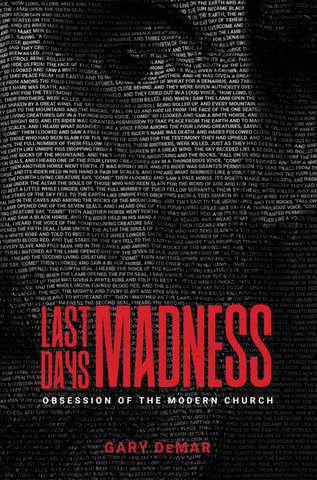Someone on Facebook wrote, “Why a Literal Historical-Grammatical Interpretation of Scripture Matters. When it comes to understanding the Bible, a literal historical-grammatical approach—taking the text at its plain meaning within its historical and literary context—is crucial.”
I agree. I find it ironic that many who advocate the LGH model are selective in how it’s applied. The following is from dispensational author Michael J. Vlach’s book Dispensational Hermeneutics.
For Dispensationalism, literal interpretation means grammatical-historical interpretation. Dispensationalism agrees with Article XV of the Chicago Statement on Biblical Hermeneutics which states, “The literal sense is the grammatical-historical sense, that is, the meaning which the writer expressed.” To summarize, Dispensationalism uses “literal interpretation” for the original intent of an author, and it is used synonymously with “grammatical-historical interpretation.”
Dispensationalists acknowledge that “symbols, figures of speech, and types” are not contrary to a literal interpretation. For example, Vlach writes, “Symbols have specific literal referents. For example, the sun, moon, and eleven stars in Genesis 37:9-10 refer to Jacob, Rachel, and Joseph’s eleven brothers.” I agree. This means that the sun, moon, and stars in Matthew 24:29 can and do refer to something other than physical sun, moon, and stars.

Prophecy Wars: The Biblical Battle Over the End Times
There is a long history of skeptics turning to Bible prophecy to claim that Jesus was wrong about the timing of His coming at “the end of the age” (Matt. 24:3) and the signs associated with it. Noted atheist Bertrand Russell (1872-1970) is one of them and Bart Ehrman is a modern example. It’s obvious that neither Russell or Ehrman are aware of or are ignoring the mountain of scholarship that was available to them that showed that the prophecy given by Jesus was fulfilled in great detail just as He said it would be before the generation of His day passed away.
Buy NowWhile searching for some information about the relationship between Matthew 24 and Luke 21, I came across a series of articles by dispensational author Thomas Ice on Matthew 24-25. Kenneth Gentry and Ice collaborated on the book The Great Tribulation: Past or Future?, which was published by Kregel Publications in 1999.
Ice is a representative of traditional (but inconsistent) dispensational hermeneutics. While researching a related topic, I found some of his comments on the Olivet Discourse about famines. Matthew (24:7), Mark (13:8), and Luke (21:11) mention famines, indicating that the accounts are parallel and refer to the same era —the generation to whom Jesus was speaking (Matt. 24:34; Mark 13:30; Luke 21:32). There were famines between Jesus’ giving His discourse and the destruction of the temple in AD 70.
It amazes me to see how prophecy writers obscure the obvious. The following is from Ice’s comments on famines in his study of Matthew 24-25:
Both famines and earthquakes are governed by the phrase “in various places.” Lenski says, “The distributive kata means, “from place to place.”[1] Leon Morris also explains: “In many places means that the disasters in question will be widespread.”[2] This global perspective fits a future understanding of the passage and cannot be limited to the first century and the area of Israel alone.
Ice quotes me from my book Last Days Madness:
[P]reterist Gary DeMar cites the following as evidence for a first century fulfillment of famines: “Beginning with the book of Acts, we see that famines were prevalent in the period prior to Jerusalem’s destruction in A.D. 70: . . . The famine was dramatic evidence that Jesus’ prophecy was coming to pass in their generation just like He said it would…. Contemporary secular historians such as Tacitus, Suetonius, and Josephus mention other famines during the period prior to A.D. 70.”[3]
Notice the ellipsis, the three dots (…), that indicates that something was left out. What I wrote, marked in bold below, refutes Ice’s argument that Jesus’ statement about famines was not fulfilled before that generation passed away as He predicted:
Beginning with the book of Acts, we see that famines were prevalent in the period before Jerusalem’s destruction in A.D. 70: “Now at this time some prophets came down from Jerusalem to Antioch. And one of them named Agabus stood up and began to indicate by the Spirit that there would certainly be a great famine all over the world [oikoumenē]. And this took place in the reign of Claudius [Roman emperor from AD 41 to 54]. And in the proportion that any of the disciples had means, each of them determined to send a contribution for the relief of the brethren living in Judea” (Acts 11:27-29).
The famine was dramatic evidence that Jesus’ prophecy was coming to pass in their generation, just like He said it would. The famine was so great that the church, as far away as Corinth, participated in relief efforts (1 Cor. 16:1-5; Rom. 15:25–28). The entire Roman Empire was affected. Futurist William T. James writes that “God’s Word has much to say about famine,”[4] and yet he does not mention Acts 11:27-29. Why? Is he afraid that his readers will ask why this passage does not fulfill what Jesus said would happen?
Contemporary secular historians such as Tacitus, Suetonius, and Josephus mention other famines during the period before AD 70. In Tacitus, we read a description of famine conditions in AD 51 in Rome: “This year witnessed many prodigies [signs or omens] … [including] repeated earthquakes…. Further portents were seen in a shortage of corn, resulting in famine…. It was established that there was no more than fifteen days’ supply of food in the city [of Rome]. Only heaven’s special favour and a mild winter prevented catastrophe.”[5] Tacitus remembers the days when Italy “once exported food for the army in distant provinces!”[6]
The passage from Acts 11:27-28 should put an end to the claim that what Jesus said about famines in the Olivet Discourse taking place before that generation passed away was not fulfilled. It satisfies “in various places … from place to place … widespread” since it was “a great famine all over the world,” that is, over the entire Roman Empire, since that’s the meaning of oikoumenē (also Luke 2:1; Matt. 24:15; Acts 17:6, 31; Rev. 3:10), the word that’s translated as “world” in many translations.

Last Days Madness
In this authoritative book, Gary DeMar clears the haze of "end-times" fever, shedding light on the most difficult and studied prophetic passages in the Bible, including Daniel 7:13-14; 9:24-27; Matt. 16:27-28; 24-25; Thess. 2; 2 Peter 3:3-13, and clearly explaining a host of other controversial topics.
Buy NowThe question is, why didn’t Ice quote my entire argument, or at least spend more time dealing with Acts 11:27-28? He claims the following “rebuts the preterist notion” of my argument:
Nor, again, is this feature in the prediction to be restricted to some such special famine as that which occurred during the reign of Claudius (Acts xi.28), too early a date for our passage, and to one or two particular cases of earthquake which happened in remote countries, and with which history has made us familiar (such as that in the neighborhood of Colossae, Oros. Hist. vii. 7, Tacit. Ann. xiv. 27 and that at Pompeii).[7]
Let’s not forget that the famine that resulted from the siege of Jerusalem led to horrific results. It’s no wonder Jesus said, “But woe to those who are with child and to those who nurse babes in those days!” (Matt. 24:19).
Josephus, a first-century eyewitness to the Roman siege of Jerusalem, describes a gruesome and dramatic story about a Jewish woman named Mary who was discovered eating cooked meat during Titus’ siege, only to identify the meat as her son. She offered some Roman soldiers half of her baby’s cooked body.
I have no idea what Meyer means by “too early a date for our passage.” It’s only too early if you believe Jesus is referring to a still distant fulfillment because “this generation” means something it does not mean elsewhere in the gospels. But it’s right on time if Jesus was describing events related to that generation. When assessing all the information, the preterist understanding of the Olivet Discourse is the most consistent Literal, Grammatical, and Historical interpretation!
[1] R. C. H. Lenski, The Interpretation of St. Matthew’s Gospel (Minneapolis: Augsburg Publishing House, 1943), 931.
[2] Leon Morris, The Gospel According to Matthew (Grand Rapids: Eerdmans, 1992), 598
[3] Gary DeMar, Last Days Madness: Obsession of the Modern Church (Powder Springs, GA: American Vision, 1999), 79.
[4] William T. James, “Daniel’s Last-Days Flood,” Foreshadows of Wrath and Redemption, William T. James, gen. ed. (Eugene, OR: Harvest House, 1999), 90.
[5] Tacitus, The Annals of Imperial Rome, trans. Michael Grant (London: Penguin Books, 1989), 271.
[6] Tacitus, The Annals of Imperial Rome, trans. Michael Grant (London: Penguin Books, 1989), 271.
[7] Heinrich August Wilhelm Meyer, Critical and Exegetical Handbook to The Gospel of Matthew, 2 vols. (Edinburgh: T. & T. Clark, 1879), 2:131.

